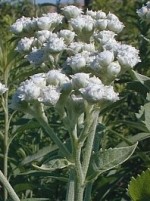 Also called American feverfew, wild quinine is a herbaceous perennial and a member of the Aster family, Asteraceae, that also includes sunflower, daisy, and lettuce. It is native to eastern North America from Quebec to Ontario, south to Florida and Texas where it grows in prairies, fields, open wooded areas, rocky woods, and hillsides. Plants grow 2-4′ tall and have stiff hairy stems and coarsely-toothed aromatic leaves covered with short bristly hairs. From late spring to mid summer woolly-looking flat topped terminal corymbs of tiny white ray flowers appear.Wild quinine is often used instead of yarrow in moist growing conditions. The genus name Parthenium, comes from the Greek word partenos meaning maiden or virgin and refers to the fact that only ray flowers are fertile. The specific epithet, integrifolium comes from the Latin words integer meaning whole, undivided and folium meaning leaf and refers incorrectly to the margins of the leaf that are actually coarsely toothed.
Also called American feverfew, wild quinine is a herbaceous perennial and a member of the Aster family, Asteraceae, that also includes sunflower, daisy, and lettuce. It is native to eastern North America from Quebec to Ontario, south to Florida and Texas where it grows in prairies, fields, open wooded areas, rocky woods, and hillsides. Plants grow 2-4′ tall and have stiff hairy stems and coarsely-toothed aromatic leaves covered with short bristly hairs. From late spring to mid summer woolly-looking flat topped terminal corymbs of tiny white ray flowers appear.Wild quinine is often used instead of yarrow in moist growing conditions. The genus name Parthenium, comes from the Greek word partenos meaning maiden or virgin and refers to the fact that only ray flowers are fertile. The specific epithet, integrifolium comes from the Latin words integer meaning whole, undivided and folium meaning leaf and refers incorrectly to the margins of the leaf that are actually coarsely toothed.
Type: Herbaceous perennial
Bloom: Flat clusters of hard white flowers are borne in summer
Foliage: Leaves are ovate to lanceolate and are coarse and hairy; basal leaves are larger than stem leaves
Size: 1-3’ H x 1-3’ W
Light: Full sun
Soil: Thrives in deep, rich, moist soil but tolerates less; drought tolerant
Hardiness: Zones 4-8
Care: Low maintenance
Pests and Diseases: None of significance
Propagation: Seeds sown in winter or spring after 4-6 weeks of cold moist stratification
Companion plants: Royal Catchfly (Silene regia), leadplant (Amorpha canescens), yellow coneflower (Ratibida pinnata).
